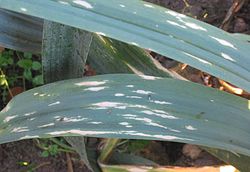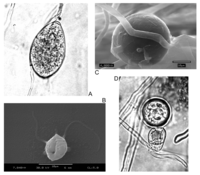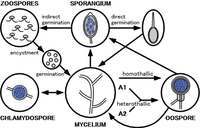Phytophthora: Perbedaan antara revisi
Kembangraps (bicara | kontrib) baru |
per BPA : tata istilah biologi: familia,keluarga -> famili | t=3'408 su=538 in=547 at=538 -- only 33 edits left of totally 572 possible edits | edr=000-0001(!!!) ovr=010-1111 aft=000-0001 |
||
| (17 revisi perantara oleh 8 pengguna tidak ditampilkan) | |||
| Baris 2: | Baris 2: | ||
| image = Prei papiervlekkenziekte Phytophthora porri on Allium porrum.jpg |
| image = Prei papiervlekkenziekte Phytophthora porri on Allium porrum.jpg |
||
| image_width = 250px |
| image_width = 250px |
||
| image_caption = ''Phytophthora porri'' |
| image_caption = Serangan ''Phytophthora porri'' pada daun [[bawang prei|prei]] |
||
| domain = [[Eukaryota]] |
| domain = [[Eukaryota]] |
||
| regnum = [[Chromalveolata]] |
| regnum = [[Chromalveolata]] |
||
| Baris 14: | Baris 14: | ||
''lihat teks'' |
''lihat teks'' |
||
}} |
}} |
||
[[File:SuddenOakDeath-USDA-Forest-Service.jpg|thumb|right|250px| |
<!-- [[File:SuddenOakDeath-USDA-Forest-Service.jpg|thumb|right|250px|Layu batang ek akibat serangan ''[[Phytophthora ramorum]]''.]] --> |
||
'''''Phytophthora''''' (dari bentukan [[bahasa Yunani]] ''φυτόν'' (''phytón''), “tumbuhan” dan ''φθορά'' (''phthorá''), “kehancuran”; “penghancur tumbuhan”) adalah salah satu [[genus |
'''''Phytophthora''''' (dari bentukan [[bahasa Yunani]] ''φυτόν'' (''phytón''), “tumbuhan” dan ''φθορά'' (''phthorá''), “kehancuran”; “penghancur tumbuhan”) adalah salah satu [[genus]] [[Oomycetes]] yang anggota-anggotanya banyak menjadi penyebab penyakit tanaman penting sehingga meinmbulkan kerugian ekonomi, ekologi, dan demografi yang besar. Marga ini dilaporkan pertama kali oleh [[Anton de Bary|Heinrich Anton de Bary]] tahun 1875. Diperkirakan ada sekitar 100 anggotanya yang telah dipertelakan, meskipun ada kemungkinan anggotanya lebih daripada itu.<ref>Brasier CM, 2009. [http://www.fs.fed.us/psw/publications/documents/psw_gtr221/psw_gtr221.pdf#page=113 Phytophthora biodiversity: how many Phytophthora species are there?] In: Goheen EM, Frankel SJ, eds. Phytophthoras in Forests and Natural Ecosystems. Albany, CA, USA: USDA Forest Service: General Technical Report PSW-GTR-221, 101–15</ref> |
||
==Biologi== |
== Biologi == |
||
[[ |
[[Berkas:Phytophtora reproduction.png|jmpl|kiri|200px|Phytophthora forms: A: Sporangia. B: Zoospore. C: Chlamydospore. D: Oospore.]] |
||
''Phytophthora'' dapat bereproduksi secara seksual maupun aseksual. Struktur reproduksi seksual jarang ditemukan di alam, tetapi dapat dirangsang di pembiakan laboratorium. Pada jenis-jenis yang ''homotalus'', struktur seksual muncul dalam satu kultur tunggal; jenis-jenis yang heterotalus memiliki dua "jenis kelamin": A1 dan A2. |
''Phytophthora'' dapat bereproduksi secara seksual maupun aseksual. Struktur reproduksi seksual jarang ditemukan di alam, tetapi dapat dirangsang di pembiakan laboratorium. Pada jenis-jenis yang ''homotalus'', struktur seksual muncul dalam satu kultur tunggal; jenis-jenis yang heterotalus memiliki dua "jenis kelamin": A1 dan A2.<!-- When mated, [[Antheridium|antheridia]] introduce gametes into [[Oogonium|oogonia]], either by the oogonium passing through the antheridium (amphigyny) or by the antheridium attaching to the proximal (lower) half of the oogonium (paragyny), and the union producing oospores. Like animals, but not like most true Fungi, meiosis is gametic, and somatic nuclei are diploid. --> |
||
[[ |
[[Berkas:Phytophthora life cycle.png|200px|kiri|The life cycle of ''Phytophthora'']] |
||
Spora aseksual (terbentuk secara mitosis) dikenal sebagai [[klamidospora]] dan [[zoospora]]. Jenis spora yang terakhir dihasilkan dalam [[sporangium]] (jamak: sporangia). |
Spora aseksual (terbentuk secara mitosis) dikenal sebagai [[klamidospora]] dan [[zoospora]]. Jenis spora yang terakhir dihasilkan dalam [[sporangium]] (jamak: sporangia).<!-- Chlamydospores are usually spherical and pigmented, and may have a thickened cell wall to aid in its role as a survival structure. Sporangia may be retained by the subtending hyphae (non-caducous) or be shed readily by wind or water tension (caducous) acting as dispersal structures. Also, sporangia may release zoospores, which have two unlike [[flagellum|flagella]] which they use to swim towards a host plant. |
||
--> |
--> |
||
| Baris 32: | Baris 32: | ||
* ''[[Phytophthora cinnamomi]]'' - causes cinnamon root rot affecting woody ornamentals including arborvitae, azalea, Chamaecyparis, dogwood, forsythia, Fraser fir, hemlock, Japanese holly, juniper, Pieris, rhododendron, Taxus, white pine, American chestnut and Australian Jarrah. |
* ''[[Phytophthora cinnamomi]]'' - causes cinnamon root rot affecting woody ornamentals including arborvitae, azalea, Chamaecyparis, dogwood, forsythia, Fraser fir, hemlock, Japanese holly, juniper, Pieris, rhododendron, Taxus, white pine, American chestnut and Australian Jarrah. |
||
* ''[[Phytophthora fragariae]]'' - causes red root rot affecting strawberries |
* ''[[Phytophthora fragariae]]'' - causes red root rot affecting strawberries |
||
* ''[[Phytophthora kernoviae]]'' - pathogen of beech and rhododendron, also occurring on other trees and shrubs including oak, and holm oak. First seen in Cornwall, UK, in 2003.<ref>{{Cite journal | doi = 10.1017/S0953756205003357 | url = http://www.forestry.gov.uk/pdf/P_kernoviae_paper_2005.pdf/$FILE/P_kernoviae_paper_2005.pdf | title = Phytophthora kernoviae sp. Nov., an invasive pathogen causing bleeding stem lesions on forest trees and foliar necrosis of ornamentals in the UK | year = 2005 | author = Brasier, C | journal = Mycological Research | volume = 109 | pages = 853 | pmid = 16175787 | last2 = Beales | first2 = PA | last3 = Kirk | first3 = SA | last4 = Denman | first4 = S | last5 = Rose | first5 = J | issue = Pt 8 | postscript = <!--None--> }}</ref> |
* ''[[Phytophthora kernoviae]]'' - pathogen of beech and rhododendron, also occurring on other trees and shrubs including oak, and holm oak. First seen in Cornwall, UK, in 2003.<ref>{{Cite journal | doi = 10.1017/S0953756205003357 | url = http://www.forestry.gov.uk/pdf/P_kernoviae_paper_2005.pdf/$FILE/P_kernoviae_paper_2005.pdf | title = Phytophthora kernoviae sp. Nov., an invasive pathogen causing bleeding stem lesions on forest trees and foliar necrosis of ornamentals in the UK | year = 2005 | author = Brasier, C | journal = Mycological Research | volume = 109 | pages = 853 | pmid = 16175787 | last2 = Beales | first2 = PA | last3 = Kirk | first3 = SA | last4 = Denman | first4 = S | last5 = Rose | first5 = J | issue = Pt 8 | postscript = --><!--None--><!-- }}</ref> |
||
* ''[[Phytophthora palmivora]]'' - causes fruit rot in coconuts and betel nuts |
* ''[[Phytophthora palmivora]]'' - causes fruit rot in coconuts and betel nuts |
||
* ''[[sudden oak death|Phytophthora ramorum]]'' – infects over 60 plant genera and over 100 host species - causes [[Sudden Oak Death]]<ref>[http://www.aphis.usda.gov/ppq/ispm/pramorum/pdf_files/usdaprlist.pdf "APHIS List of Regulated Hosts and Plants Associated with ''Phytophthora ramorum''" U.S. Animal and Plant Health Inspection Services];</ref> |
* ''[[sudden oak death|Phytophthora ramorum]]'' – infects over 60 plant genera and over 100 host species - causes [[Sudden Oak Death]]<ref>[http://www.aphis.usda.gov/ppq/ispm/pramorum/pdf_files/usdaprlist.pdf "APHIS List of Regulated Hosts and Plants Associated with ''Phytophthora ramorum''" U.S. Animal and Plant Health Inspection Services];</ref> |
||
| Baris 42: | Baris 42: | ||
==Fungi resemblance== |
==Fungi resemblance== |
||
''Phytophthora'' is sometimes referred to as a [[fungi|fungal]]-like organism but it is classified under a different kingdom altogether: [[Chromalveolata]] (formerly [[heterokont|Stramenopila]] and previously [[Chromista]]). This is a good example of [[convergent evolution]]: ''Phytophthora'' is morphologically very similar to true fungi yet its evolutionary history is quite distinct. In contrast to fungi, stramenopiles are more closely related to plants than animals. Whereas fungal cell walls are made primarily of [[chitin]], stramenopile cell walls are constructed mostly of [[cellulose]]. Ploidy levels are different between these two groups; Phytophthora have [[diploid]] (paired) chromosomes in the vegetative (growing, non-reproductive) stage of life, Fungi are almost always [[haploid]] in this state. Biochemical pathways also differ, notably the highly conserved [[Lysine]] synthesis path. |
''Phytophthora'' is sometimes referred to as a [[fungi|fungal]]-like organism but it is classified under a different kingdom altogether: [[Chromalveolata]] (formerly [[heterokont|Stramenopila]] and previously [[Chromista]]). This is a good example of [[convergent evolution]]: ''Phytophthora'' is morphologically very similar to true fungi yet its evolutionary history is quite distinct. In contrast to fungi, stramenopiles are more closely related to plants than animals. Whereas fungal cell walls are made primarily of [[chitin]], stramenopile cell walls are constructed mostly of [[cellulose]]. Ploidy levels are different between these two groups; Phytophthora have [[diploid]] (paired) chromosomes in the vegetative (growing, non-reproductive) stage of life, Fungi are almost always [[haploid]] in this state. Biochemical pathways also differ, notably the highly conserved [[Lysine]] synthesis path. |
||
--> |
--> |
||
| ⚫ | |||
| ⚫ | |||
''[[Phytophthora boehmeriae]]''<br/> |
''[[Phytophthora boehmeriae]]''<br/> |
||
''[[Phytophthora botryosa]]''<br/> |
''[[Phytophthora botryosa]]''<br/> |
||
| Baris 71: | Baris 69: | ||
''[[Phytophthora hibernalis]]''<br/> |
''[[Phytophthora hibernalis]]''<br/> |
||
''[[Phytophthora humicola]]''<br/> |
''[[Phytophthora humicola]]''<br/> |
||
''[[Phytophthora hydropathica]]''<ref name="csa new species">{{cite web|url=http://md1.csa.com/partners/viewrecord.php?requester=gs&collection=ENV&recid=8354020&q=Phytophthora+drechsleri&uid=1337633&setcookie=yes|title=Phytophthora irrigata and Phytophthora hydropathica, two new species from irrigation water at ornamental plant nurseries |
''[[Phytophthora hydropathica]]''<ref name="csa new species">{{cite web|url=http://md1.csa.com/partners/viewrecord.php?requester=gs&collection=ENV&recid=8354020&q=Phytophthora+drechsleri&uid=1337633&setcookie=yes|title=Phytophthora irrigata and Phytophthora hydropathica, two new species from irrigation water at ornamental plant nurseries|last=Hong|first=C|coauthors=Gallegly, M, Richardson, P, Kong, P, Moorman, G, Lea-Cox, J, Ross, D|date=June 2008|work=Phytopathology Vol. 98, no. 6|accessdate=2009-06-05|archive-date=2012-03-07|archive-url=https://web.archive.org/web/20120307184325/http://md1.csa.com/partners/viewrecord.php?requester=gs&collection=ENV&recid=8354020&q=Phytophthora+drechsleri&uid=1337633&setcookie=yes|dead-url=yes}}</ref><br/> |
||
''[[Phytophthora irrigata]]''<ref name="csa new species" /><br/> |
''[[Phytophthora irrigata]]''<ref name="csa new species" /><br/> |
||
''[[Phytophthora idaei]]''<br/> |
''[[Phytophthora idaei]]''<br/> |
||
| Baris 86: | Baris 84: | ||
''[[Phytophthora mirabilis]]''<br/> |
''[[Phytophthora mirabilis]]''<br/> |
||
''[[Phytophthora multivesiculata]]''<br/> |
''[[Phytophthora multivesiculata]]''<br/> |
||
''[[Phytophthora nemorosa]]''<ref>Hansen, Everett M.; Reeser, P. W.; Davidson, J. M.; Garbelotto, Matteo; Ivors, K.; Douhan, L.; and Rizzo, David M. (2003) "[http://nature.berkeley.edu/garbelotto/downloads/hansen2003.pdf ''Phytophthora nemorosa'', a new species causing cankers and leaf blight of forest trees in California and Oregon, U.S.A] ''Mycotaxon'' |
''[[Phytophthora nemorosa]]''<ref>Hansen, Everett M.; Reeser, P. W.; Davidson, J. M.; Garbelotto, Matteo; Ivors, K.; Douhan, L.; and Rizzo, David M. (2003) "[http://nature.berkeley.edu/garbelotto/downloads/hansen2003.pdf ''Phytophthora nemorosa'', a new species causing cankers and leaf blight of forest trees in California and Oregon, U.S.A] ''Mycotaxon'' 88: pp. 129-138</ref><br/> |
||
''[[Phytophthora nicotianae]]''<br/> |
''[[Phytophthora nicotianae]]''<br/> |
||
''[[Phytophthora palmivora]]''<br/> |
''[[Phytophthora palmivora]]''<br/> |
||
| Baris 105: | Baris 103: | ||
''[[Phytophthora vignae]]'' |
''[[Phytophthora vignae]]'' |
||
== |
== Referensi == |
||
{{Reflist|2}} |
{{Reflist|2}} |
||
==Bacaan tambahan== |
== Bacaan tambahan == |
||
* Lucas, J.A. ''et al.'' (eds.) (1991) ''Phytophthora'' based on a symposium held at Trinity College, Dublin, Ireland September 1989. British Mycological Society, Cambridge University Press, Cambridge, UK, ISBN 0-521-40080-5 ; |
* Lucas, J.A. ''et al.'' (eds.) (1991) ''Phytophthora'' based on a symposium held at Trinity College, Dublin, Ireland September 1989. British Mycological Society, Cambridge University Press, Cambridge, UK, ISBN 0-521-40080-5 ; |
||
* Erwin, Donald C. and Ribeiro, Olaf K. (1966) ''Phytophthora Diseases Worldwide'' American Phytopathological Society Press, St. Paul, Minnesota, ISBN 0-89054-212-0 |
* Erwin, Donald C. and Ribeiro, Olaf K. (1966) ''Phytophthora Diseases Worldwide'' American Phytopathological Society Press, St. Paul, Minnesota, ISBN 0-89054-212-0 |
||
* Erwin, Donald C. (1983) ''Phytophthora: its biology, taxonomy, ecology, and pathology'' American Phytopathological Society Press, St. Paul, Minnesota, ISBN 0-89054-050-0 |
* Erwin, Donald C. (1983) ''Phytophthora: its biology, taxonomy, ecology, and pathology'' American Phytopathological Society Press, St. Paul, Minnesota, ISBN 0-89054-050-0 |
||
* [http://www.aphis.usda.gov/ppq/ispm/pramorum/pdf_files/usdaprlist.pdf "APHIS List of Regulated Hosts and Plants Associated with ''Phytophthora ramorum''" U.S. Animal and Plant Health Inspection Services] |
* [http://www.aphis.usda.gov/ppq/ispm/pramorum/pdf_files/usdaprlist.pdf "APHIS List of Regulated Hosts and Plants Associated with ''Phytophthora ramorum''" U.S. Animal and Plant Health Inspection Services] {{Webarchive|url=https://web.archive.org/web/20061212185042/http://www.aphis.usda.gov/ppq/ispm/pramorum/pdf_files/usdaprlist.pdf |date=2006-12-12 }} |
||
* [http://www.naturebase.net/content/category/4/302/97/ "Dieback" Department of Environment and Conservation, Western Australia] |
* [http://www.naturebase.net/content/category/4/302/97/ "Dieback" Department of Environment and Conservation, Western Australia] {{Webarchive|url=https://web.archive.org/web/20070914081121/http://www.naturebase.net/content/category/4/302/97/ |date=2007-09-14 }} |
||
==Pranala luar== |
== Pranala luar == |
||
{{commons category}} |
{{commons category}} |
||
{{Wikispecies|Phytophthora}} |
{{Wikispecies|Phytophthora}} |
||
*[http://www.btny.purdue.edu/USDA-ARS/Goodwin_lab/results/Phytoph_biblio.html Goodwin, Stephen B. (January 2001) "Phytophthora Bibliography" Purdue University] |
* [http://www.btny.purdue.edu/USDA-ARS/Goodwin_lab/results/Phytoph_biblio.html Goodwin, Stephen B. (January 2001) "Phytophthora Bibliography" Purdue University] {{Webarchive|url=https://web.archive.org/web/20061014125542/http://www.btny.purdue.edu/USDA-ARS/Goodwin_lab/results/Phytoph_biblio.html |date=2006-10-14 }} |
||
*[http://www.ladybug.uconn.edu/factsheets/tp_05_phytophthora.html Abbey, Tim (2005) "Phytophthora Dieback and Root Rot" College of Agriculture and Natural Resources, University of Connecticut] |
* [http://www.ladybug.uconn.edu/factsheets/tp_05_phytophthora.html Abbey, Tim (2005) "Phytophthora Dieback and Root Rot" College of Agriculture and Natural Resources, University of Connecticut] {{Webarchive|url=https://web.archive.org/web/20070506074931/http://www.ladybug.uconn.edu/factsheets/tp_05_phytophthora.html |date=2007-05-06 }} |
||
*[http://www.bartlett.com/resources/Phytophthora-Canker.cfm "Phytophthora Canker - Identification, Biology and Management"] Bartlett Tree Experts Online Resource Library |
* [http://www.bartlett.com/resources/Phytophthora-Canker.cfm "Phytophthora Canker - Identification, Biology and Management"] Bartlett Tree Experts Online Resource Library |
||
*[http://www.bartlett.com/resources/Phytophthora-Root-Rot.cfm "Phytophthora Root Rot - Identification, Biology and Management"] Bartlett Tree Experts Online Resource Library |
* [http://www.bartlett.com/resources/Phytophthora-Root-Rot.cfm "Phytophthora Root Rot - Identification, Biology and Management"] Bartlett Tree Experts Online Resource Library |
||
*[http://www.dwg.org.au/ Dieback Working Group] - Western Australia |
* [http://www.dwg.org.au/ Dieback Working Group] - Western Australia |
||
{{Taxonbar|from=Q311294}} |
|||
[[Kategori:Oomycetes]] |
[[Kategori:Oomycetes]] |
||
[[ |
[[Kategori:Penyakit tumbuhan]] |
||
[[de:Phytophthora]] |
|||
[[en:Phytophthora]] |
|||
[[es:Phytophthora]] |
|||
[[eo:Phytophthora]] |
|||
[[fr:Phytophthora]] |
|||
[[it:Phytophthora]] |
|||
[[nl:Phytophthora]] |
|||
[[ja:エキビョウキン]] |
|||
[[pt:Phytophthora]] |
|||
[[sv:Phytopthora infestans]] |
[[sv:Phytopthora infestans]] |
||
Revisi terkini sejak 8 Juli 2022 01.26
| Phytophthora | |
|---|---|

| |
| Serangan Phytophthora porri pada daun prei | |
| Klasifikasi ilmiah | |
| Domain: | |
| Kerajaan: | |
| Filum: | |
| Kelas: | |
| Ordo: | |
| Famili: | |
| Genus: | Phytophthora
|
| Spesies | |
|
lihat teks | |
Phytophthora (dari bentukan bahasa Yunani φυτόν (phytón), “tumbuhan” dan φθορά (phthorá), “kehancuran”; “penghancur tumbuhan”) adalah salah satu genus Oomycetes yang anggota-anggotanya banyak menjadi penyebab penyakit tanaman penting sehingga meinmbulkan kerugian ekonomi, ekologi, dan demografi yang besar. Marga ini dilaporkan pertama kali oleh Heinrich Anton de Bary tahun 1875. Diperkirakan ada sekitar 100 anggotanya yang telah dipertelakan, meskipun ada kemungkinan anggotanya lebih daripada itu.[1]
Biologi
[sunting | sunting sumber]
Phytophthora dapat bereproduksi secara seksual maupun aseksual. Struktur reproduksi seksual jarang ditemukan di alam, tetapi dapat dirangsang di pembiakan laboratorium. Pada jenis-jenis yang homotalus, struktur seksual muncul dalam satu kultur tunggal; jenis-jenis yang heterotalus memiliki dua "jenis kelamin": A1 dan A2.

Spora aseksual (terbentuk secara mitosis) dikenal sebagai klamidospora dan zoospora. Jenis spora yang terakhir dihasilkan dalam sporangium (jamak: sporangia).
Spesies
[sunting | sunting sumber]Phytophthora boehmeriae
Phytophthora botryosa
Phytophthora brassicae
Phytophthora cactorum
Phytophthora cajani
Phytophthora cambivora
Phytophthora capsici
Phytophthora cinnamomi
Phytophthora citricola
Phytophthora citrophthora
Phytophthora clandestina
Phytophthora colocasiae
Phytophthora cryptogea
Phytophthora drechsleri
Phytophthora erythroseptica
Phytophthora fragariae
Phytophthora fragariae var. rubi
P. gemini
Phytophthora glovera
Phytophthora gonapodyides
Phytophthora heveae
Phytophthora hibernalis
Phytophthora humicola
Phytophthora hydropathica[2]
Phytophthora irrigata[2]
Phytophthora idaei
Phytophthora ilicis
Phytophthora infestans
Phytophthora inflata
Phytophthora iranica
Phytophthora katsurae
Phytophthora lateralis
Phytophthora medicaginis
Phytophthora megakarya
Phytophthora megasperma
Phytophthora melonis
Phytophthora mirabilis
Phytophthora multivesiculata
Phytophthora nemorosa[3]
Phytophthora nicotianae
Phytophthora palmivora
Phytophthora phaseoli
Phytophthora pini
Phytophthora porri
Phytophthora plurivora
Phytophthora primulae
Phytophthora pseudosyringae
Phytophthora pseudotsugae
Phytophthora quercina
Phytophthora ramorum
Phytophthora sinensis
Phytophthora sojae
Phytophthora syringae
Phytophthora tentaculata
Phytophthora trifolii
Phytophthora vignae
Referensi
[sunting | sunting sumber]- ^ Brasier CM, 2009. Phytophthora biodiversity: how many Phytophthora species are there? In: Goheen EM, Frankel SJ, eds. Phytophthoras in Forests and Natural Ecosystems. Albany, CA, USA: USDA Forest Service: General Technical Report PSW-GTR-221, 101–15
- ^ a b Hong, C (June 2008). "Phytophthora irrigata and Phytophthora hydropathica, two new species from irrigation water at ornamental plant nurseries". Phytopathology Vol. 98, no. 6. Diarsipkan dari versi asli tanggal 2012-03-07. Diakses tanggal 2009-06-05.
- ^ Hansen, Everett M.; Reeser, P. W.; Davidson, J. M.; Garbelotto, Matteo; Ivors, K.; Douhan, L.; and Rizzo, David M. (2003) "Phytophthora nemorosa, a new species causing cankers and leaf blight of forest trees in California and Oregon, U.S.A Mycotaxon 88: pp. 129-138
Bacaan tambahan
[sunting | sunting sumber]- Lucas, J.A. et al. (eds.) (1991) Phytophthora based on a symposium held at Trinity College, Dublin, Ireland September 1989. British Mycological Society, Cambridge University Press, Cambridge, UK, ISBN 0-521-40080-5 ;
- Erwin, Donald C. and Ribeiro, Olaf K. (1966) Phytophthora Diseases Worldwide American Phytopathological Society Press, St. Paul, Minnesota, ISBN 0-89054-212-0
- Erwin, Donald C. (1983) Phytophthora: its biology, taxonomy, ecology, and pathology American Phytopathological Society Press, St. Paul, Minnesota, ISBN 0-89054-050-0
- "APHIS List of Regulated Hosts and Plants Associated with Phytophthora ramorum" U.S. Animal and Plant Health Inspection Services Diarsipkan 2006-12-12 di Wayback Machine.
- "Dieback" Department of Environment and Conservation, Western Australia Diarsipkan 2007-09-14 di Wayback Machine.
Pranala luar
[sunting | sunting sumber]- Goodwin, Stephen B. (January 2001) "Phytophthora Bibliography" Purdue University Diarsipkan 2006-10-14 di Wayback Machine.
- Abbey, Tim (2005) "Phytophthora Dieback and Root Rot" College of Agriculture and Natural Resources, University of Connecticut Diarsipkan 2007-05-06 di Wayback Machine.
- "Phytophthora Canker - Identification, Biology and Management" Bartlett Tree Experts Online Resource Library
- "Phytophthora Root Rot - Identification, Biology and Management" Bartlett Tree Experts Online Resource Library
- Dieback Working Group - Western Australia
